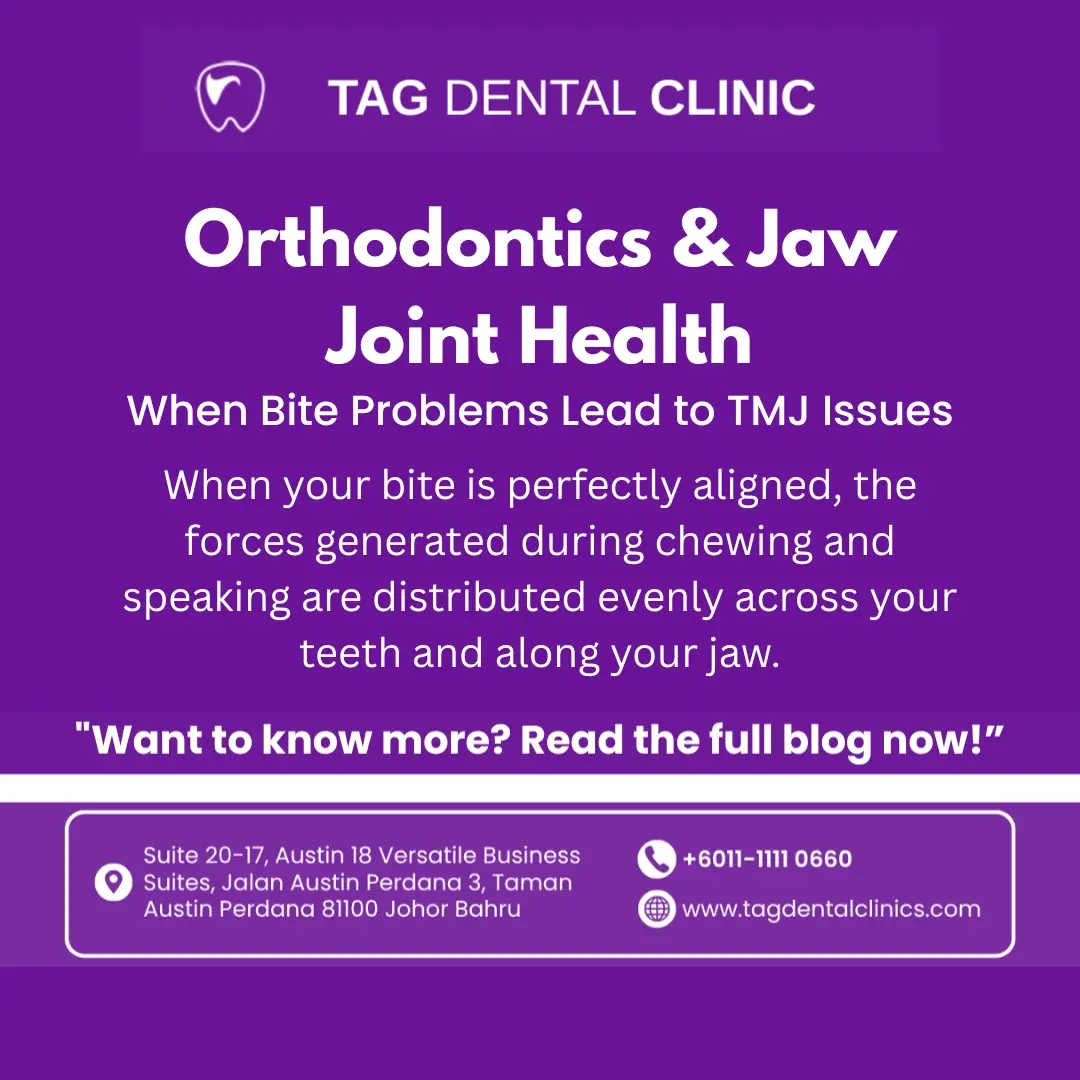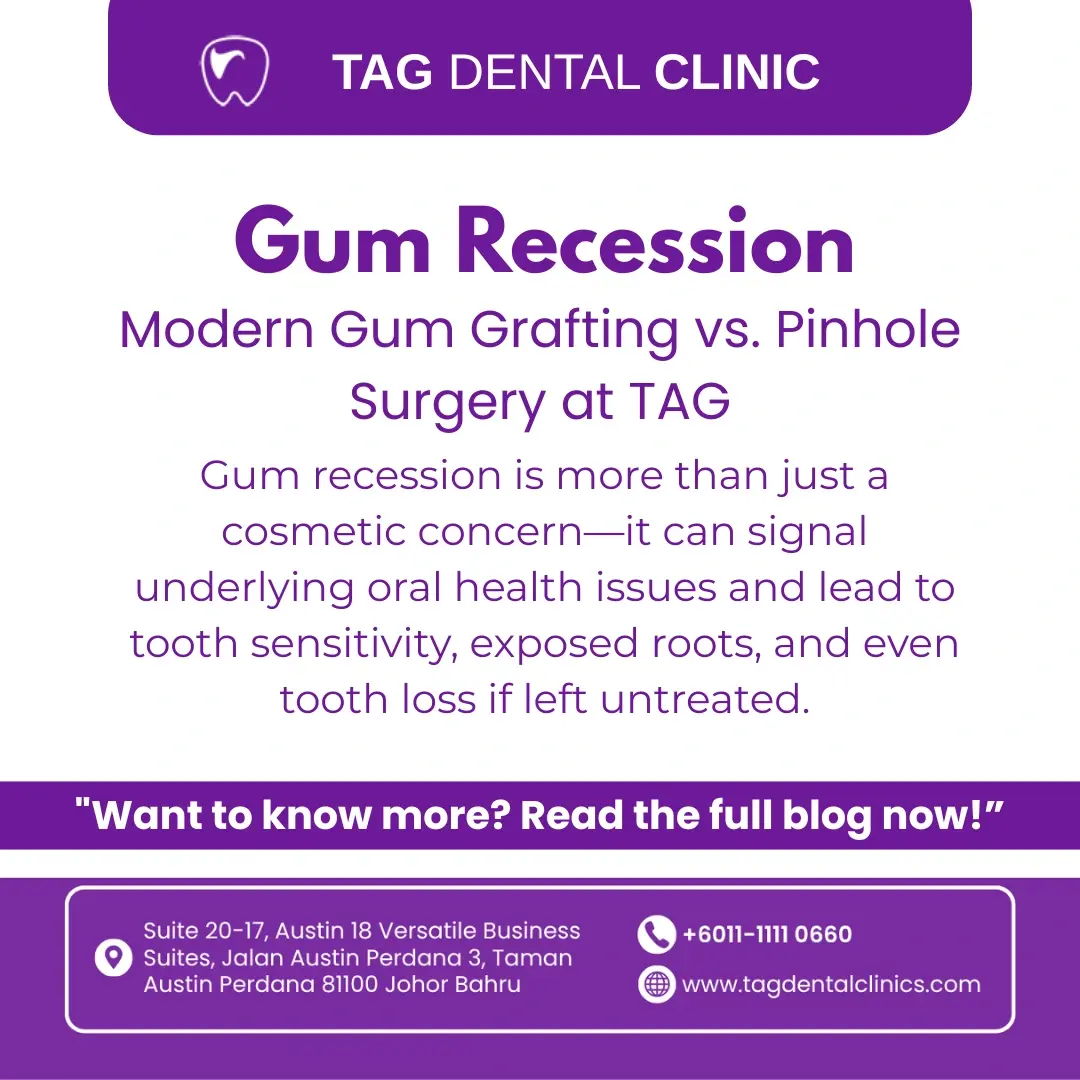Orthodontics & Jaw Joint Health: When Bite Problems Lead to TMJ Issues
Table Of Content

The Hidden Connection: How Your Bite Affects Your Jaw Joint
The way your upper and lower teeth meet is known as your bite or occlusion. When your bite is perfectly aligned, the forces generated during chewing and speaking are distributed evenly across your teeth and along your jaw. However, when you suffer from malocclusion (a bad bite) or bite misalignment, this harmony is shattered.
This misalignment can create immense, unnatural pressure on one of the most complex joints in your body: the Temporomandibular Joint (TMJ), which connects your jawbone to your skull. TMJ disorders (TMD) can lead to chronic pain and significant disruption of your daily life.
At TAG Dental in Johor Bahru, our orthodontic and general dentistry teams work together. We understand that correcting your bite is often the essential step in resolving persistent jaw joint problems.
How Malocclusion Stresses the TMJ

The jaw joint acts like a sliding hinge, and it relies on precise balance. When your teeth are misaligned, several issues stress this joint:
1. Uneven Muscle Workload
If your teeth don't fit together correctly, the muscles that control chewing and jaw movement must strain and overcompensate to force the jaws into a comfortable closed position. This constant tension and fatigue in the jaw and facial muscles is a primary cause of TMJ pain.
2. Direct Joint Overload
In cases like a severe overbite (deep bite) or underbite, the teeth hit each other at incorrect angles. This can directly force the delicate cushioning disc within the TMJ out of its proper position. Over time, this chronic overload causes wear-and-tear on the joint cartilage, leading to damage.
3. Teeth Grinding and Clenching (Bruxism)
Misaligned bites can trigger subconscious habits like bruxism (teeth grinding or clenching). This dramatically increases the force placed on the teeth and the jaw joint, accelerating wear on the joint tissues and amplifying pain.
4. Head and Neck Posture
Your bite, jaw position, and neck posture are intrinsically linked. Bite problems can cause you to unconsciously hold your head in an awkward position to compensate for the jaw misalignment, leading to neck and shoulder tension that contributes to TMD symptoms.
Recognizing the Signs and Symptoms of TMJ Issues

TMJ problems can manifest in various ways, often mimicking other conditions like tension headaches or ear infections. It’s important to recognize these common signs:
- Jaw Pain and Tenderness: Pain around the joint area, often radiating into the face, neck, or shoulders.
- Clicking, Popping, or Grating Sounds: Audible sounds when opening or closing your mouth, caused by the disc within the joint slipping out of place.
- Limited Jaw Movement: Difficulty opening your mouth wide, or the jaw occasionally "locking" in an open or closed position.
- Headaches and Ear Symptoms: Persistent headaches (especially tension headaches or migraines), earaches, ringing in the ears (tinnitus), or a sensation of fullness in the ear.
- Facial Swelling: Swelling on the side of your face around the joint.
- Bite Changes: A sudden or gradual change in the way your upper and lower teeth fit together.
If you experience any of these symptoms in Johor Bahru, it’s crucial to seek professional evaluation at TAG Dental. Ignoring these signs can lead to worsening joint damage and chronic pain.
How Orthodontic Planning Integrates TMJ Care

At TAG Dental, our approach to orthodontics goes far beyond simply straightening teeth for aesthetics. True orthodontic health focuses on achieving a functional, stable bite that protects the TMJ.
1. Comprehensive Diagnostic Assessment
Our planning process always begins with a detailed assessment:
- Advanced Imaging: We use high-resolution digital X-rays to evaluate the structure of your teeth, bone, and critically, the TMJ itself.
- Bite Analysis: We analyze your bite mechanics—where your teeth touch, how your jaw moves, and the muscle function—to identify the exact source of the stress.
2. The Focus on Centric Relation
The goal of our orthodontic treatment is to place the teeth into a position known as centric relation—the most stable and relaxed position of the jaw joint. When the teeth meet in this position, the jaw muscles are relaxed, and the forces are evenly distributed, relieving chronic stress on the TMJ.
3. Treatment Planning for Stability
Orthodontic treatments like traditional braces, clear aligners (Invisalign), and functional appliances are used to meticulously move the teeth and restructure the dental arches. This corrects the underlying malocclusion, whether it’s an open bite, crossbite, or overcrowding. By correcting the bite, we naturally reduce the pressure on the TMJ, often leading to the cessation of clicking and a reduction in pain.
In some cases, treatment might begin with a specialized oral appliance, like a splint or night guard, to immediately stabilize the joint and relax the muscles before the full orthodontic correction begins.
Frequently Asked Questions (FAQs) About Bite Problems and TMJ

1. Can fixing my bite really cure my headaches? Yes, in many instances. If your headaches are caused by chronic muscle tension resulting from a misaligned bite, correcting the bite through orthodontics often resolves the underlying cause of the headaches.
2. Is TMJ treatment always surgical? No. The vast majority of TMJ disorders are treated non-surgically, using approaches that include orthodontic treatment, oral splints, physical therapy, and medication.
3. How often should I wear a night guard if I clench my teeth? A night guard should be worn every night unless otherwise instructed by your dentist, as clenching or grinding often occurs subconsciously during sleep.
4. Can children have TMJ issues? While more common in adults, children can develop TMJ issues, often linked to underdeveloped jaws, thumb-sucking habits, or severe malocclusions. Early orthodontic intervention can prevent these issues from worsening.
5. How long does it take to see TMJ improvement after starting orthodontic treatment? Patients often report a reduction in muscle tension and pain within the first few months, as the bite begins to stabilize and the jaw muscles start to relax into a healthier position.
6. Does fixing overcrowding help with TMJ? Yes. Severe overcrowding can force the jaw to shift into an unnatural position to find a stable closing point, straining the TMJ. Correcting overcrowding removes this compensatory stress.
7. Are clear aligners (like Invisalign) suitable for TMJ patients? Clear aligners are often an excellent option for TMJ patients, as they gently and precisely guide the teeth and bite into alignment, focusing on achieving that healthy, stable centric relation.
8. Can a missing tooth cause TMJ problems? Yes. When a tooth is missing, the neighboring teeth tilt and the opposing tooth over-erupts, drastically altering the bite and creating uneven pressure on the TMJ.
9. Is TMJ pain caused by stress? Stress often exacerbates TMJ symptoms because many people subconsciously respond to stress by clenching their jaw or grinding their teeth (bruxism), which significantly stresses the joint.
10. What is the very first thing TAG Dental does to diagnose my TMJ issue? We conduct a comprehensive clinical examination, assessing joint movement, muscle tenderness, and performing a detailed digital analysis of your bite and jaw alignment.
Your Path to a Pain-Free, Balanced Smile in Johor Bahru

At TAG Dental, our focus is on comprehensive, lasting health. We don't view orthodontic treatment merely as a cosmetic procedure, but as a critical component of achieving a stable, functional bite that protects the health of your TMJ for life.
If you suffer from chronic headaches, jaw pain, or clicking sounds, the root cause may lie in your bite alignment. We invite you to schedule a specialized orthodontic and TMJ assessment with our expert team in Johor Bahru today. Take the first step toward a pain-free life and a balanced, beautiful smile.





